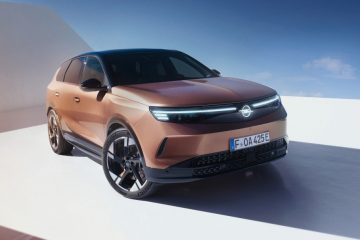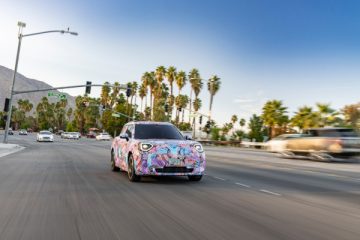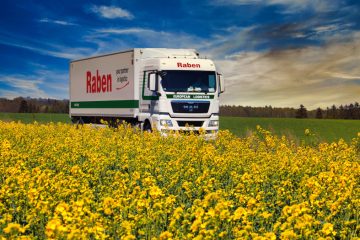 The innovations presented by the Octavia model range in Geneva are designed to bring pleasure in the everyday use of the car. The Octavia name has long been associated with ŠKODA’s history. While the current model’s forerunners rank among the most successful in the company’s history, it was the modern-day Octavia that triggered the brand’s unprecedented success in the car world. The current, second-generation is easily identifiable thanks to the elegant and dynamic look of both the five-door liftback and the spacious estate. On the heels of the environmental diesel GreenLine and Green tec versions of the Octavia introduced last year, ŠKODA has now come up with another version of the Green tec, this time with a petrol engine. The GreenLine and Green tec versions are characterized by their economical running with significantly lower fuel consumption and CO2 emissions.
The innovations presented by the Octavia model range in Geneva are designed to bring pleasure in the everyday use of the car. The Octavia name has long been associated with ŠKODA’s history. While the current model’s forerunners rank among the most successful in the company’s history, it was the modern-day Octavia that triggered the brand’s unprecedented success in the car world. The current, second-generation is easily identifiable thanks to the elegant and dynamic look of both the five-door liftback and the spacious estate. On the heels of the environmental diesel GreenLine and Green tec versions of the Octavia introduced last year, ŠKODA has now come up with another version of the Green tec, this time with a petrol engine. The GreenLine and Green tec versions are characterized by their economical running with significantly lower fuel consumption and CO2 emissions.
From the 2012 model year, the upgraded Amundsen+ navigation system with factory-installed maps will be available for the Octavia. Customers will be able to take their pick of two versions of maps: Eastern and Central Europe or Western and Central Europe. The navigation device also features a CD player and radio, which can optionally be complemented with digital DAB radio reception and a Bluetooth module for handsfree phoning while driving. The new optional independent heating remote control offers an even higher degree of comfort. The new metallic Lava Blue and Platin Grey will gradually expand the choice of body colours.
It’s not just the diesel it’s easy on: the Octavia Green tec – now with a petrol engine
The second version of the Octavia Green tec is equipped with a powerful, yet efficient, 1.4 TSI/90 kW (122 hp) engine. This is the first time that ŠKODA has combined the economical technology of GreenLine models with a petrol engine. The innovative Start-Stop and brake energy regeneration systems have thus expanded the opportunities available to join the ranks of environmentally responsible motorists.
The Octavia Green tec can be ordered in two body versions – the liftback and the estate. The 200 Nm of torque available between 1,500 and 4,000 rpm gives the car the exceptional dynamism craved by even the most demanding customers. Nevertheless, the engine, coupled with the economical technology, is extremely efficient, consuming 5.8 litres per 100 km, equating to CO2 emissions of 134 g/km. The Green tec models can be identified by the green letter “i” on the label indicating the engine.
Timeless elegance: design
The Octavia’s design remains timelessly elegant. The front end, with its 19-slat chrome grille and flat, horizontal upper surface which blends into the domed bonnet and sleek front wings, makes a very dynamic first impression.
The headlamps, which can be fitted with optional xenon lights and adaptive front lighting, are large and dominant, their individualistic concept emphasizing the Octavia’s front end. A bold crease runs from the ŠKODA logo in the chrome rim above the grille, across the bonnet and towards the windscreen, visually connecting with the centre console of the passenger compartment.
The front fog lamps, sitting underneath the front bumper with its distinct horizontal alignment, are equipped with enhanced active safety features in the form of daytime running and cornering lights. The side mirrors with integrated indicators are electrically adjustable and heated even at the Classic entry level. Power retractable side mirrors are fitted as standard in the Elegance and L&K trims and are optional in all others. The C-shaped rear lights have become an instantly recognizable hallmark of ŠKODA cars. “Cats’ eyes” are integrated into the rear bumper so that the Octavia remains highly visible not only on the road, but also when it is parked.
State-of-the-art technology under the bonnet: engines
The Octavia model series includes four versions with a diesel engine and optimized consumption. The Octavia GreenLine boasts a record consumption of 3.8 l/100 km and combined CO2 emissions of 99 g/km; the GreenLine is also available as an estate with CO2 emissions of 107 g/km. The range also includes the Octavia Green tec and Octavia Combi Green tec, with combined consumption of 4.2 l/100 km and CO2 emissions of 109 g/km. These outstanding results are achieved by means of an efficient 1.6 TDI CR 77 kW (105 bhp) engine with maximum torque of 250 Nm between 1,500 and 2,000 rpm. A Start-Stop system, drastically reducing fuel consumption in urban traffic, is installed as standard. The brake energy regeneration system converts the kinetic energy generated during braking into electrical energy, which is stored in the battery. Then, when the engine comes under greater stress, this electricity reserve is drawn from the battery; as a result, the alternator does not consume as much engine power as it would in a car without a regeneration system. Aerodynamic body and chassis modifications and tyres with lower rolling resistance round off the fuel efficiency features. The list of optional equipment for the GreenLine version is limited, and items such as larger wheels and towing devices are unavailable. In contrast, in the Green tec versions few optional items have been removed from the list.
The upgraded Octavia offers six petrol engines, one MultiFuel engine, one LPG engine and four diesel engines. The basic Octavia engine is the 1.4-litre petrol engine, delivering 59 kW (80 bhp) and torque of 132 Nm at 3,800 rpm. This engine uses just 6.4 litres of petrol per 100 kilometres and has CO2 emissions of 149 g/km. It is equipped with a five-speed manual gearbox.
The next level up in the Octavia range is the 1.2 TSI petrol engine. It delivers 77 kW (105 bhp) and produces its maximum 175 Nm torque over a wide range from 1,550 to 4,100 rpm. With this engine, the Octavia accelerates from 0 to 100 km/h in 10.8 seconds and has a top speed of 192 km/h. Combined fuel consumption is 5.7 litres per 100 kilometres. CO2 emissions are a mere 134 g/km. The 1.2 TSI petrol engine can be combined with either a manual six-speed gearbox or automatic seven-speed dual-clutch DSG.
The 1.4 TSI 90 kW (122 bhp) engine produces maximum torque of 200 Nm between 1,500 and 4,000 rpm. With this engine, the Octavia achieves a top speed of 203 km/h and accelerates from 0 to 100 km/h in 9.7 seconds. This engine, small in displacement but big in performance, is also very frugal. Its combined consumption is only 6.3 litres per 100 km, equating to CO2 emissions of 148 g/km. The 1.4 TSI engine can be combined with either a manual six-speed gearbox or automatic seven-speed dual-clutch DSG.
The 1.8 TSI 118 kW (160 bhp) petrol engine can be combined with either a manual six-speed gearbox or automatic seven-speed DSG. The six-speed manual version is also available for the four-wheel drive versions, including the Octavia Scout.
The 1.6 TDI CR DPF/77 kW (105 bhp) diesel engine, which produces its maximum torque of 250 Nm between 1,500 and 2,500 rpm, is specifically tuned for economy and so features in the Octavia GreenLine family. In the rest of the Octavia model range, it replaces the 1.9 TDI PD engine. Besides a five-speed manual gearbox, when equipped with front-wheel drive it can be combined with the DSG seven-speed automatic transmission, while four-wheel versions feature a six-speed manual gearbox.
For the more powerful 2.0 TDI CR DPF/103 kW diesel engine, a highly attractive combination of a six-speed automatic DSG transmission and four-wheel drive is available, a configuration which can be ordered not only for the Octavia Combi, but also for the stylishly attractive Octavia Scout.
Besides the GreenLine versions, there is plenty of engine choice for Octavia customers:
Petrol engines:
· 1.4 MPI/59 kW (80 bhp), CO2 emissions of 149 g/km
· 1.6 MPI/75 kW (102 bhp), CO2 emissions of 176 g/km
· 1.6 MPI/75 kW (102 bhp), CO2 emissions of 162 g/km, E85 157 g/km
· 1.6 MPI/75 kW (102 bhp), LPG/72 kW (98 bhp), CO2 emissions of 169 g/km, LPG 149 g/km
· 1.2 TSI/77 kW (105 bhp), CO2 emissions of 134 g/km, DSG 136 g/km
· 1.4 TSI/90 kW (122 bhp), CO2 emissions of 148 g/km, DSG 147 g/km, Green tec 134 g/km
· 1.8 TSI/118 kW (160 bhp), CO2 emissions of 158 g/km, DSG 155 g/km
· 2.0 TSI/147 kW (200 bhp), CO2 emissions of 175 g/km – RS
Diesel engines:
· 1.6 TDI CR DPF/77 kW (105 bhp), CO2 emissions of 119 g/km,
DSG 123 g/km,
GreenLine 99 g/km;
Combi GreenLine 107 g/km (as of CW 22/2011)
Green tec 109 g/km
· 2.0 TDI PD/81 kW (110 bhp), CO2 emissions of 132 g/km
· 2.0 TDI CR DPF/103 kW (140 bhp), CO2 emissions of 126 g/km; DSG 138 g/km
· 2.0 TDI CR DPF 125 kW (170 bhp), CO2 emissions 149 g/km – RS
The Octavia LPG is a redesigned version of the 1.6 MPI/75 kW petrol engine. When run on petrol, the engine output is 75 kW (102 bhp), whereas LPG reduces the output slightly to 72 kW (98 bhp). Maximum torque is produced at 3,800 rpm and is rated at 148 Nm for petrol and 144 Nm for LPG. Consumption amounts to 7.1 litres of petrol or 9.2 litres of liquefied gas per 100 km. The 44-litre fuel tank is integrated into the spare wheel well beneath the luggage compartment. The tank is fuelled via a safety valve with a push-push latch next to the fuel tank filler neck. With this solution, the Octavia’s loading capacity remains virtually the same – 560 litres in the liftback, 580 litres in the estate. The Octavia LPG is primarily supplied to markets with a dense network of LPG dispensing stations where LPG tax advantages substantially decrease operating costs.
Up to the mark and extensive: equipment range
The interior emphasis is on comfort, ease of operation and the careful selection of materials. New-look instruments with white scales predominate on the dashboard, while the multi-function display shows information from the on-board computer. The rotary controls for both the Climatic and Climatronic air-conditioning systems are electronically operated and include heated front seat switches.
The folding armrest in the middle of the rear fold-down seats houses a storage compartment; the rear side of the Jumbo Box between the front seats contains controls for the passengers in the back to heat their seats (this is an optional feature in the Octavia). A mesh pocket in the centre console on the front passenger’s side offers additional storage space. The Jumbo Box under the armrest between the two front seats is fitted with a cooling function connected to the air-conditioning.
Rear seat passengers enjoy the Octavia’s maximum comfort and space – among the best in this class – while the large doors make entering and exiting the vehicle easier. The tailgate is so big that storing luggage in the liftback’s class-leading 585-litre luggage compartment is simple. Folding down the rear seats extends the volume to a remarkable 1,455 litres, a capacity which expands from 605 to 1,655 litres in the estate version.
The Octavia can be fitted with parking distance control via fifth-generation parking sensors. The system uses two speakers and two different signals to distinguish a decreasing distance in front of or behind the car.
Important equipment items:
· Bolero radio and the Amundsen+ and Columbus navigation systems with touchscreen colour monitor
· MDI (Media Device Interface) – a new connection for an iPod, Aux-in (3.5 mm jack), USB or mini-USB device that can be controlled via the radio or ŠKODA navigation system, with data shown either on the MDI display or on the Maxi DOT screen
· GSM III Premium phone preparation
· new WOKS headrests on the front seats, incorporated as standard in all Octavias
· fifth-generation parking sensors with detailed display on the radio or the ŠKODA navigation system screen
· fourth generation immobilizer – protection identical to the system used in the Superb
· fourth-generation Haldex clutch in the Octavia Combi 4×4 and Scout
ATHLETISM DOWN THE GENERATIONS – THE Octavia rs
The agile sportiness of the Octavia RS, boosted by its dynamic design, builds on the 110-year tradition of motor sport enjoyed by the carmaker from Mladá Boleslav. Yet the RS also shares the strengths of the Octavia designed for everyday use and comfortable family trips over long distances. Economy, spaciousness, reliability and safety continue to be traditional virtues of these cars.
The well-balanced characteristics of the Octavia RS were brought up to date by a facelift the year before last, which included an even more expressive front end design, new alloy wheel designs and new body colours. Inside, driver and passengers are greeted by RS Decor or, optionally, RS Supreme leather upholstery. The Climatronic air conditioning is now equipped with a sensor which constantly measures the quality of the air drawn into the vehicle and, if necessary, automatically switches to recirculation mode.
The face of the Octavia RS is dominated by its grille with the RS legend, which extends into the equally bold headlamps. These can be equipped with xenon lamps and adaptive front lighting. The front bumper, with its wide air intake, houses cornering fog lamps and LED daytime running lights which consume just 50 W of power.
The ground clearance of the Octavia RS has been lowered by 13 millimetres compared to the regular version (12 millimetres on the estate), while a palette of seven body colours is on offer. Optional 7.5J x 18″ Neptune wheels are available over the standard 17″ Zenith alloys.
The list of comfort, safety and function options is extensive and includes numerous opportunities to customize the Octavia RS. The RS Supreme interior, in a leather/artificial leather combination trim, and exclusive sill guards round off the sporty ambience.
All of the Octavia RS engines meet the EU 5 emissions standard. Despite producing 147 kW (200 bhp) at 5,100 – 6,000 rpm, the 2.0 TSI petrol engine also achieves combined fuel consumption of only 7.5 l/100 km, while combined CO2 emissions are 175 g/km. Its diesel sibling, the 2.0 TDI with common rail injection and diesel particulate filter, has an output of 125 kW (170 bhp) and maximum torque of 350 Nm between 1,750 and 2,500 rpm. Average consumption of 5.7 l/100 km and CO2 emissions of just 149 g/km are particularly impressive.
In 2000, ŠKODA introduced the first in a new series of sporty cars full of dynamism and agility that draw their inspiration from the company’s long-standing motorsport tradition. Far ahead of their time, the company founders Václav Laurin and Václav Klement looked to compare quality in races on both paved and dirt roads. In the early 1970s, the letters RS (Rally Sport) appeared for the first time on the ŠKODA 180 RS and ŠKODA 200 RS rally cars. The ŠKODA 130 RS, which reigned supreme on circuits and in mountain races, tapped into their potential. Its greatest successes include its touring car victory at the Rally Monte-Carlo in 1977 and the European Touring Car Championship in 1981.
sTYLE, MOBILITY AND PERFORMANCE – THE octavia scout
The Scout design line has built up a firm position in the range of ŠKODA models, its exceptional status underscored by exclusive interior and exterior features. Robust and self-confident, the Octavia Scout also represents ŠKODA’s FWD capability, making it ideally suited both to daily use in challenging conditions and to leisure activities. So far, the Octavia Scout has reported 31,000 sales. From the 2011 model year, Proteus polished 17" alloy wheels and economical LED daytime running lights will be available.
The cross-country mobility, dynamic capability and comfort of the Octavia Scout are perfectly balanced. The 179 mm ground clearance and Rough Road Pack significantly enhance its off-road suitability, as does the four-wheel drive, which is controlled by the fourth-generation Haldex clutch. The variable torque distribution between both axles provides impressive traction, ensuring safe progress even on unsurfaced roads. The Scout can also be equipped with Hill Start Assist as an option. Two reliable and powerful engines – the 1.8 TSI/118 kW (EU 5) and 2.0 TDI CR/DPF 103 kW (EU 5) – combined with a manual six-speed gearbox ensure optimal performance. A new development is the four-cylinder 2.0 TDI CR DPF/103 kW engine combined with a six-speed DSG.
Inside, both driver and passengers enjoy high comfort levels, high-quality materials and meticulous workmanship. The upholstery is made of wear-resistant fabric which is pleasant to the touch. The front seat passenger is sure to appreciate the grab handle on the dashboard, which is another distinct and exclusive detail of this model. The two-zone Climatronic air conditioning is equipped with a sensor which constantly measures the quality of the air and, if necessary, automatically switches to recirculation mode.




